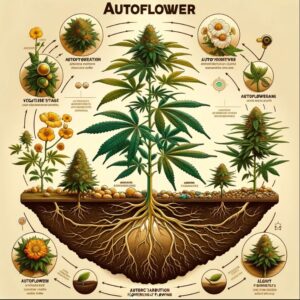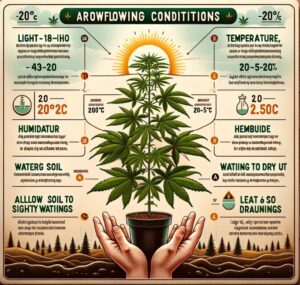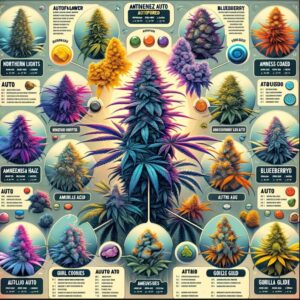Autoflower Seeds: The Beginner’s Guide to Maximizing Your Harvest
Autoflower Seeds: The Beginner’s Guide to Maximizing Your Harvest
What are Autoflowers?
Embarking on the journey of growing plants can be an incredibly rewarding experience, especially when it comes to cultivating autoflower seeds. These unique seeds have revolutionized the world of gardening, offering a simpler and more efficient way to grow plants, particularly cannabis. Autoflower seeds, as the name suggests, are types of seeds that automatically switch from the vegetative stage to the flowering stage based on age, rather than the light cycle. This distinctive feature makes them an ideal choice for beginners and those looking to maximize their harvest with minimal effort.
The allure of autoflower seeds lies in their simplicity and the speed at which they grow. Unlike traditional plants that require specific light cycles to flower, autoflowers eliminate the need for light schedule adjustments, making them easier to manage and perfect for those who may not have the luxury of controlled indoor growing conditions. Whether you’re a novice gardener or a seasoned grower looking to streamline your process, understanding the basics of autoflower seeds can significantly enhance your gardening experience. This guide aims to provide you with essential insights and practical tips to maximize your harvest, from selecting the right seeds to harvesting your bounty.
Introduction to Autoflower Seeds
Autoflower seeds are a marvel in the world of gardening, offering an uncomplicated and time-efficient approach to plant cultivation. These seeds are genetically engineered to switch from the vegetative stage to the flowering stage automatically, without the need for specific light cycles. This characteristic makes them an excellent choice for beginners and those seeking to optimize their growing process.
What are Autoflower Seeds?
Autoflower seeds come from the crossbreeding of Cannabis Ruderalis with either Cannabis Indica or Cannabis Sativa strains. Cannabis Ruderalis, a species native to Russia, has naturally adapted to extreme environments, developing the ability to flower based on age rather than light exposure. By integrating these genetics, autoflower seeds inherit this automatic flowering trait, enabling them to bloom after a set period, typically within 2 to 4 weeks of germination, regardless of light conditions.
Benefits of Choosing Autoflower Seeds for Your Garden
- Simplicity and Speed: Autoflower plants have a straightforward cultivation process and a quicker growth cycle. They can be harvested in as little as 8-10 weeks from seed, allowing for multiple growing cycles in a single season.
- Resilience: These plants are generally more robust and resistant to pests and diseases, thanks to their Ruderalis heritage. This resilience makes them suitable for various climates and growing conditions.
- Space Efficiency: Autoflowering plants tend to be smaller and more compact, making them ideal for indoor spaces or discreet outdoor gardens.
- No Need for Light Cycle Management: Unlike regular strains that require changes in light exposure to flower, autoflowers bloom automatically, eliminating the need for complex lighting setups.
Understanding these key aspects of autoflower seeds can significantly impact your gardening success, providing an efficient route to a rewarding harvest. Whether you’re looking to cultivate cannabis for medicinal purposes or seeking a hassle-free gardening experience, autoflower seeds offer a compelling solution.

Choosing the Right Autoflower Seeds
Selecting the right autoflower seeds is crucial to achieving your gardening goals, whether you’re aiming for a bountiful harvest, specific plant characteristics, or ease of cultivation. With the vast array of autoflower seeds available in the market, making an informed choice can significantly impact your growing success.
Factors to Consider When Selecting Autoflower Seeds:
- Strain Type: Consider whether you prefer a Sativa, Indica, or hybrid strain, as each offers different effects, growth patterns, and flowering times. Sativas tend to grow taller, while Indicas are more compact and bushy.
- Yield Potential: Look for strains known for their high yield potential if your goal is a plentiful harvest. Some autoflower strains can produce substantial yields despite their small size.
- Potency and CBD/THC Ratios: Depending on your intended use, whether medicinal or recreational, the cannabinoid profile is a significant factor. Some strains are bred for high THC content, while others are rich in CBD.
- Growth Difficulty: Autoflower seeds are generally beginner-friendly, but some strains might require more care and attention than others. Choose a strain that matches your experience level and growing conditions.
- Climate and Environment Compatibility: Ensure the strain you choose is suited to your growing environment, whether indoor or outdoor. Some autoflowers are particularly resilient and can thrive in less-than-ideal conditions.
Recommendations for Top Autoflower Seed Strains:
- Northern Lights Auto: Renowned for its resilience and impressive yields, this Indica-dominant strain is perfect for beginners and provides a relaxing effect.
- Amnesia Haze Auto: For those seeking a more energetic and uplifting experience, this Sativa-dominant strain offers a great taste and substantial yields.
- Blueberry Auto: Known for its flavor and medicinal qualities, this strain is both easy to grow and provides a relaxing, therapeutic effect.
- Girl Scout Cookies Auto: A popular choice for its balanced effects and high THC content, this hybrid strain offers excellent flavors and decent yields.
- Gorilla Glue Auto: This strain is celebrated for its potent effects and strong resin production, ideal for those looking for a high-THC option.
By considering these factors and recommendations, you can select autoflower seeds that will meet your gardening objectives, ensuring a satisfying and productive growing experience.
Optimal Conditions for Autoflowering Plants
Creating the ideal environment for your autoflowering plants is key to maximizing their growth potential and yield. Despite their reputation for being resilient and low-maintenance, paying attention to certain environmental factors can significantly enhance the health and productivity of your autoflower garden.
Understanding the Ideal Growing Environment:
- Light: While autoflowers don’t require a change in light cycles to bloom, they do thrive on light. Offering 18-24 hours of light per day can optimize their growth and yield. LED or full-spectrum lights are recommended for indoor growers to mimic natural sunlight.
- Temperature: Autoflowers prefer a consistent temperature range between 20°C to 25°C (68°F to 77°F). Extreme temperatures can stress the plants, affecting their growth and yield.
- Humidity: Maintaining a relative humidity level around 40-50% during the flowering stage is ideal. Proper ventilation and dehumidifiers can help control humidity levels, especially in indoor setups.
Lighting, Watering, and Soil Requirements:
- Watering: Overwatering is a common mistake with autoflowers due to their smaller size and rapid growth cycle. It’s essential to allow the soil to dry out slightly between waterings to prevent root rot and ensure optimal nutrient uptake.
- Soil: Autoflowers do best in light, airy soil with good drainage. A soil mix designed for cannabis, with a balanced pH of around 6.5, can provide an ideal growing medium. Avoid heavy, compact soils that can hinder root growth.
- Nutrients: Autoflowers require fewer nutrients compared to regular cannabis plants. Using a nutrient solution specifically formulated for autoflowers, or a less concentrated mix, can prevent nutrient burn and promote healthy growth.
By understanding and implementing these optimal conditions, you can create a thriving environment for your autoflowering plants, ensuring a robust and fruitful harvest.

Care and Maintenance of Autoflowering Plants
Proper care and maintenance are essential to maximize the health and yield of your autoflowering plants. While autoflowers are known for their ease of cultivation, certain best practices can help you avoid common pitfalls and ensure a successful grow.
Tips for Nurturing Your Plants from Seed to Harvest:
- Gentle Nutrition: Autoflowers require less nutrition compared to photoperiod strains. Start with a mild nutrient solution and gradually increase the strength as your plants mature, being cautious to avoid overfeeding.
- Training Techniques: To maximize light exposure and air circulation, consider gentle training techniques like Low Stress Training (LST). Avoid high-stress techniques like topping, as autoflowers have a limited time to recover from stress.
- Monitoring Plant Health: Regularly inspect your plants for signs of stress, pests, or diseases. Early detection and intervention can prevent minor issues from becoming major problems.
- pH Management: Ensure the water and nutrient solution are at the correct pH level, ideally between 6.0 and 7.0 for soil and slightly lower for hydroponic setups. pH imbalances can hinder nutrient uptake, affecting plant health.
- Timely Harvest: Autoflowers have a rapid life cycle. Monitor the trichomes and pistils to determine the optimal harvest time. Harvesting too early or too late can affect the potency and yield.
Common Pitfalls to Avoid in the Growing Process:
- Overwatering: Autoflowers have smaller root systems. Overwatering can lead to root rot and oxygen deprivation. Ensure adequate drainage and let the topsoil dry out between waterings.
- Excessive Training or Pruning: Autoflowers’ fast growth cycle means they have less time to recover from stress. Avoid aggressive pruning or training methods.
- Ignoring Environmental Conditions: Even though autoflowers are adaptable, extreme conditions can still stress them. Maintain a stable environment to prevent growth stunting.
By adhering to these care and maintenance guidelines, you can nurture your autoflowering plants effectively, leading to a healthy and abundant harvest.
Harvesting and Enjoying Your Yield
The culmination of your hard work and dedication in growing autoflowering plants is the harvest. Knowing when and how to harvest your plants can significantly impact the quality and potency of your yield. Following the harvest, proper drying, curing, and storage are crucial to enjoy the full benefits of your plants.
When and How to Harvest Autoflowering Plants:
- Timing is Key: The optimal time to harvest is when the trichomes (the small, crystal-like structures on the flowers) are mostly cloudy with some turning amber. This indicates peak THC/CBD levels.
- Method: Use sharp, sterilized scissors to cut the branches or colas. Handle the plants gently to avoid trichome loss, which can reduce potency.
- Gradual Harvesting: Sometimes, not all parts of the plant mature at the same rate. You can harvest mature colas first and give the rest of the plant more time to develop.
Post-Harvest Processing:
- Drying: Hang the harvested branches upside down in a dark, well-ventilated room with a consistent temperature and humidity level. This process typically takes about 7-10 days.
- Curing: Once dry, trim any remaining leaves and place the buds in airtight jars, opening them daily for the first week to release moisture and prevent mold. Curing enhances the flavor, aroma, and potency of the buds.
- Storage: Store the cured buds in a cool, dark place. Properly cured and stored cannabis can last for an extended period without losing its effectiveness.
By mastering the harvesting process and post-harvest care, you can ensure that your autoflowering plants provide the highest quality yield, allowing you to fully enjoy the fruits of your labor.
Care and Maintenance of Autoflowering Plants
Proper care and maintenance are essential to maximize the health and yield of your autoflowering plants. While autoflowers are known for their ease of cultivation, certain best practices can help you avoid common pitfalls and ensure a successful grow.
Tips for Nurturing Your Plants from Seed to Harvest:
- Gentle Nutrition: Autoflowers require less nutrition compared to photoperiod strains. Start with a mild nutrient solution and gradually increase the strength as your plants mature, being cautious to avoid overfeeding.
- Training Techniques: To maximize light exposure and air circulation, consider gentle training techniques like Low Stress Training (LST). Avoid high-stress techniques like topping, as autoflowers have a limited time to recover from stress.
- Monitoring Plant Health: Regularly inspect your plants for signs of stress, pests, or diseases. Early detection and intervention can prevent minor issues from becoming major problems.
- pH Management: Ensure the water and nutrient solution are at the correct pH level, ideally between 6.0 and 7.0 for soil and slightly lower for hydroponic setups. pH imbalances can hinder nutrient uptake, affecting plant health.
- Timely Harvest: Autoflowers have a rapid life cycle. Monitor the trichomes and pistils to determine the optimal harvest time. Harvesting too early or too late can affect the potency and yield.
Common Pitfalls to Avoid in the Growing Process:
- Overwatering: Autoflowers have smaller root systems. Overwatering can lead to root rot and oxygen deprivation. Ensure adequate drainage and let the topsoil dry out between waterings.
- Excessive Training or Pruning: Autoflowers’ fast growth cycle means they have less time to recover from stress. Avoid aggressive pruning or training methods.
- Ignoring Environmental Conditions: Even though autoflowers are adaptable, extreme conditions can still stress them. Maintain a stable environment to prevent growth stunting.
By adhering to these care and maintenance guidelines, you can nurture your autoflowering plants effectively, leading to a healthy and abundant harvest.
Harvesting and Enjoying Your Yield
The culmination of your hard work and dedication in growing autoflowering plants is the harvest. Knowing when and how to harvest your plants can significantly impact the quality and potency of your yield. Following the harvest, proper drying, curing, and storage are crucial to enjoy the full benefits of your plants.
When and How to Harvest Autoflowering Plants:
- Timing is Key: The optimal time to harvest is when the trichomes (the small, crystal-like structures on the flowers) are mostly cloudy with some turning amber. This indicates peak THC/CBD levels.
- Method: Use sharp, sterilized scissors to cut the branches or colas. Handle the plants gently to avoid trichome loss, which can reduce potency.
- Gradual Harvesting: Sometimes, not all parts of the plant mature at the same rate. You can harvest mature colas first and give the rest of the plant more time to develop.
Post-Harvest Processing:
- Drying: Hang the harvested branches upside down in a dark, well-ventilated room with a consistent temperature and humidity level. This process typically takes about 7-10 days.
- Curing: Once dry, trim any remaining leaves and place the buds in airtight jars, opening them daily for the first week to release moisture and prevent mold. Curing enhances the flavor, aroma, and potency of the buds.
- Storage: Store the cured buds in a cool, dark place. Properly cured and stored cannabis can last for an extended period without losing its effectiveness.
By mastering the harvesting process and post-harvest care, you can ensure that your autoflowering plants provide the highest quality yield, allowing you to fully enjoy the fruits of your labor.
Conclusion – Autoflower Seeds
Embarking on the journey of growing autoflower seeds can be a rewarding and enlightening experience. By choosing the right seeds, providing optimal growing conditions, and adhering to proper care and maintenance practices, even novice gardeners can achieve bountiful harvests. The simplicity and resilience of autoflowering plants make them a fantastic choice for those looking to streamline their gardening efforts while ensuring a successful yield.
Remember, the key to a successful autoflower garden lies in understanding the unique needs of these plants and adjusting your care techniques accordingly. From selecting the ideal strain to mastering the harvest and curing process, each step you take is a learning opportunity and a chance to enhance your gardening skills.
As you gain experience and confidence, you’ll find that growing autoflower seeds is not just about the end product but also about the joy of the growing process itself. So, embrace the journey, learn from each cycle, and enjoy the fruits of your labor. Happy gardening!
